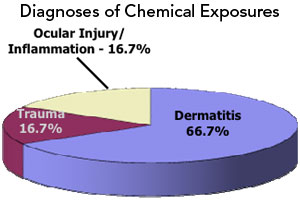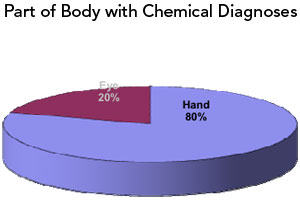Chemical Contact
Chemical Exposure – Third most frequent work-related injury of blueberry harvesters
Exposure to Chemicals – 5% of injuries and illnesses of blueberry harvesters
Important on-site requirements for growers that can help you with diagnosis and
treatment:
- Chemical information should be posted in the field in a central location.
- A decontamination site for chemical handlers is required.
- Information on chemical exposures to farmworkers and their care-givers is
mandatory. - Growers need to conform to REI (Restricted Entry Interval) recommendations:
- Generally: REI is 12 hours
- Chemicals with a Caution label: REI is 24 hours
- Chemicals with a Danger label: REI is 48 hours



Chemicals – General Information
Becoming familiar with these chemical properties may help you with diagnosis & treatment:
- Organic carbon adsorption coefficient, K oc: describes the relative affinity or attraction of the chemical to soil materials (its mobility in soil).
- Biological degradation half-life, T1/2 : measure of persistence of the chemical in soil.
- Maximum contaminant level (MCL), or the lifetime health advisory level (HAL) : Measure of health risk to humans of chemical contaminated drinking water.
- Aquatic toxicity, LC 50 : Measure of the ability of the chemical to cause 50% mortality in aquatic test species.
Chemical Information Summary
| Common Name | Trade Names | Days to Harvest | Re-entry Interval | To Bees | Toxicity Top Applicator |
|
|---|---|---|---|---|---|---|
| Oral | Dermal | |||||
| Azinphosmethyl | APM, Sniper, Guthion | 14 | High | High | Moderate | |
| Bacillus Thuringiensis | Foray | 0 | Low | Low | Low | |
| Boscalid | Lance | 0 | 4 hours | Low | Low | Low |
| Captan | Captan, Maestro | 2 | 48 – 72 hours | Low | Low | Low |
| Deltamethrin | Decis | 14 | High | Low | Low | |
| Dimethoate | Cygon, System, Lagon | 15 | High | Moderate | Moderate | |
| Fenhexamid | Elevate | 1 | Low | Low | Low | |
| Ferbam | Ferbam | 40 | Low | Low | Low | |
| Propiconazole | Topas | 60 | Low | Low | Low | |
| Permethrin | Pounce | Sprout | High | Moderate | Low | |
| Phosmet | Imidan | 15 | High | Moderate | Low | |
| Pyraclostrobin | Cabrio | 1 | 24 hours | Low | Low | Low |
| Thiophanatemethyl | Easout, Senator | 1 | Low | Low | Low | |
| Trichlorfon | Dylox | 30 | Moderate | Moderate | Moderate | |
| Triforine | Funginex | 60 | Low | Low | Low | |
*“Days to harvest” is the minimum number of days from the last application of the product to first harvest.
*This is not an exhaustive list of chemicals. This list contains only those chemicals that migrant and seasonal blueberry harvesters are most likely to encounter.
Rick Delbridge and Dick Rogers. Wild Blueberry Insect and Disease Management Schedule. AgraPoint International Inc., 2004. Available online.
Patterns of Chemical Usage through the Blueberry Season
Rates of product are for mature plants
Dormant, Spring, Summer & Fall |
|||
|---|---|---|---|
| Insect / Disease | Product | Rate / ha | Note |
| Godronia & Phomopsis canker | Physical removal / cultural | Prune out and burn infected wood. Remove red-flagging shoots during the growing season. | |
Green Tip |
|||
| Mummy berry (Monilinia) | Funginex 190 EC Topas 250 E |
1.7 L 500 mL |
The maximum residue limit is now zero in the US. Topas may still be used in Canada, however, treated blueberries are not suitable for shipment to the US since they may contain Topas residues. Apply if mummy berry has been a problem previously. Apply when green tissue is showing and mature apothecial cups are present. Apply a second application 10-14 days later. |
| Anthracnose & Phomopsis canker | Cabrio 20 EG Bravo 500 |
1.0 kg 7.2 L |
Do not apply more than 2 consecutive applications of Cabrio. |
| Blueberry leaftier (Croesia curvalana) | Decis 5 EC | 150 mL | Label recommends 1200-1500 L water per hectare. Will also control spanworm (125 mL) (and other caterpillars such as winter moth and leafrollers) if applied when insects or damage first appears prior to bloom. For more info on blueberry leaftier, refer to insect fact sheets section at: www.gov.ns.ca/nsaf/elibrary/archive/hort/wildblue/insects/ |
Pink Bud |
|||
| Anthracnose & Phomopsis canker | Same as Green Tip section | ||
Bloom
|
|||
| Botrytis blossom blight & fruit rot | Maestro 80 DF Captan 80 WDG Elevate 50 WDG Lance 70 WDG Ferbam 76 WDG |
2.25 kg 2.25 kg 1.70 kg 0.56 kg 3.75 kg |
Creates problem when wet periods occur. Apply fungicides at 7-10 day intervals. Use shorter interval when disease pressure is high. Don’t apply more than 2 consecutive applications of Elevate or Lance (are from different chemical families) before alternating to another effective fungicide with a different mode of action. Don’t apply Ferbam beyond mid bloom. |
Petal Fall |
|||
| Anthracnose & Phomopsis canker | Same as Green Tip section | Do not apply Bravo beyond petal fall. | |
| Cherry fruitworm (Grapholitha packardi) & Cranberry fruitworm (Acrobasis vaccinii) | Guthion Solupak Sniper Malathion 25 W Sevin XLR PLUS | 1.12 kg 1.12 kg 2.25 kg 4.00 L |
Cherry fruitworm is native to North America. In Canada it had only been reported from Ontario and British Columbia. |
Early Berries Begin to Ripen |
|||
| Blueberry fruit fly (Rhagoletis mendax) or Blueberry maggot fly | Lagon 480 E Guthion Solupak Sniper Imidan 50 WP Sevin XLR PLUS Malathion 25 W |
825 mL 2.25 kg 2.25 kg 2.25 kg 4.00 L 2.25 kg |
DO NOT apply Lagon more than two times per season and DO NOT apply to foliage when the temperature is 25°C or higher. Apply insecticides for blueberry fruit fly 5-10 days after the first adult fly is captured in a Rhagoletis yellow panel trap. A second spray may be necessary if flies continue to be captured 7-10 days after the first spray. |
| Botrytis fruit rot | Maestro 80 DF Captan 80 WDG Elevate 50 WDG Lance 70 WDG |
2.25 kg 2.25 kg 1.70 kg 0.56 kg |
Apply fungicides at 7-10 day intervals. Do not apply more than 2 consecutive applications of Elevate or Lance (are from different chemical families) before alternating to another effective fungicide with a different mode of action. |
Rick Delbridge and Dick Rogers. Highbush Blueberry Insect and Disease Management Schedule. AgraPoint International Inc., May 2004. Available online.